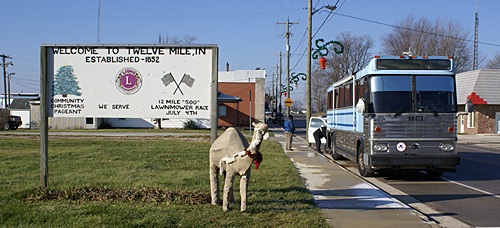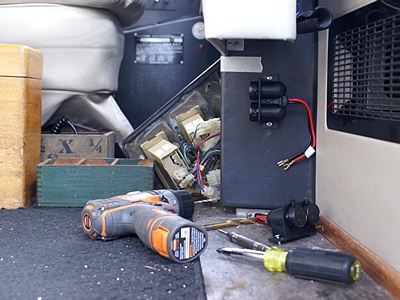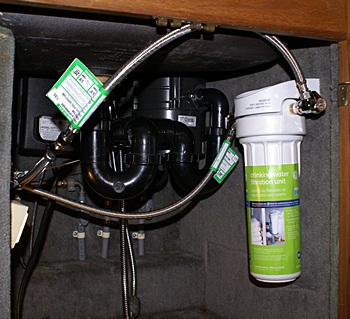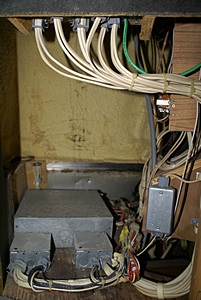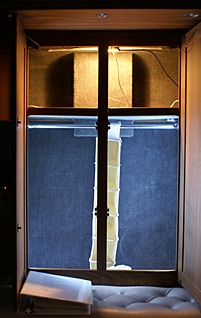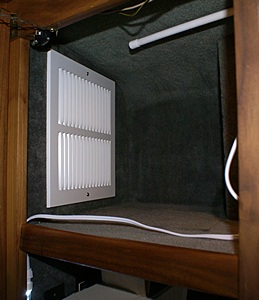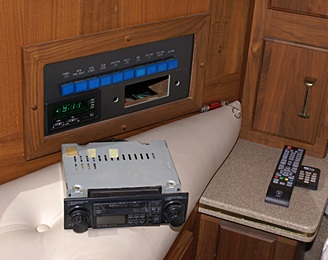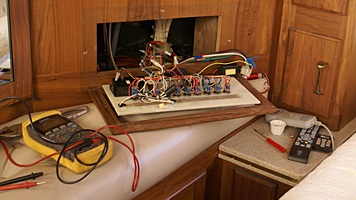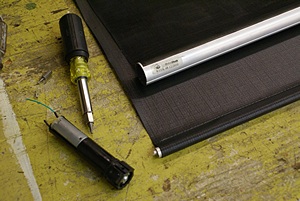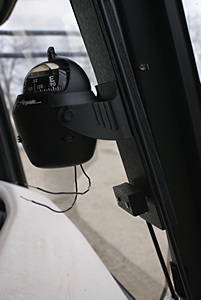2014/12/01 (M) Back in Twelve Mile IN
As I indicated in yesterday’s post we are back in Twelve Mile, Indiana for a couple of days before heading on towards the southwest United States. Butch and Fonda are scrambling to get ready and although there isn’t much we can do to help, we have made ourselves available. If nothing else we can cheer them on.
We went to bed early last night, tired from our final departure preparations and 270 miles of travel yesterday, and slept in this morning. Once we were up we had our usual granola with fresh fruit for breakfast and then walked over to Small Town Brew for coffee and conversation with owner Lisa Paul and whoever else happened in while we were there.
Well caffeinated, and pushing 9:30 AM, we checked in on Butch and Fonda. There wasn’t anything we could help with so we both set up our computers and got online. Linda paid bills while I updated the spreadsheet I use to track cross-purchase costs. I hooked up their small Canon iP90 inkjet printer and printed out a copy for Butch and wrote him a check for the balance we owed them. I showed Linda the MFJ-998 full legal limit antenna tuner that Butch wanted to sell and decided to buy it, resulting in a second check. We plan to (eventually) use this in our base station, but it was a good enough deal that it was worth buying now and transporting to Arizona and back. Buying it now also helped out our friends. I logged in to RVillage and updated our location while Linda walked down to the Post Office two buildings to the west. (Twelve Mile is a pretty small, compact town.)
Bill and Butch finished repairing Brittiny’s car this past week and she and Rock showed up mid-morning to pick it up. We visited with them for a while and then Rock headed back while Brittiny visited with her mom. While they were talking someone stopped across the street and off-loaded a camel. They had three on the trailer but I’m not sure where they put the other two. The three wise men, however, were nowhere to be seen.
Although the air temperature was in the upper 20’s it was sunny most of the day, which kept the front of the bus comfortable and well lit. Given those conditions I decided to work on some projects in the center cockpit area.
First up was (finally) mounting the inclinometer, which turned out to be quite the little project. I had to remove the mounting bracket from the case in order to attach it to my mounting blocks on the center windshield pillar. That, in turn, required me to take the case apart and remove the mechanism so I could get to the ‘C’ clips that prevented the bracket retaining screws from coming all the way out of the body. But I got it apart, mounted, and reassembled, minus the retaining clips. Really, why would I put them back in?
Linda split the one remaining Tofurkey brand Italian sausage and served it on a couple of hotdog buns for lunch along with a couple of Clementine oranges. A quick and simple but tasty lunch.
The inclinometer and the compass both have light bulbs in them and needed to be wired up to 12VDC accessory plugs. The inclinometer already had a power cord but the compass did not, so I got some scrap wire from Butch and fashioned a 2-conductor power cable. I only have four accessory outlets and three of them were already in use so I attached both power cables to a single plug using wire nuts. I then dressed all of the wires to make for a neater looking installation that would keep them out of the way and prevent snagging and/or tripping problems. All of this was a long-term temporary solution; I plan to eventually install a 12 VDC PowerPole distribution system for all of these accessories and hide the wiring to the extent possible or enclose it split cable loom.
I removed the four screws that hold the panel with the 12 VDC house system switches so I could get to the back side of them. It took a while but I eventually puzzled out how the three air-conditioner switches were wired. I removed the wire that feeds +12 VDC to the Rear A-C switch and checked for voltage at the loose end of the wire. There wasn’t any, as expected, so I put a 2 Amp blade fuse in the 12 VDC distribution panel and checked again. This time I had +13.2 VDC, so everything was good down to that point. I removed the line and load wires from each switch in turn and checked to make sure the contacts opened and closed the way they should. They did, so I checked each pin to ground to see if any of them were somehow shorted to ground. They were not, so the problem was probably downstream from there. I did not, however, specifically check the bulb circuit for each switch, so I don’t know if there’s a problem there or not. The bulbs, however, get their power from the load side of each switch, so in the next paragraph the tests I did included the bulbs in parallel with whatever other loads existed.
I tested each load wire for continuity to ground and was surprised that they each appeared as a short. I did this test with the DC- lead to ground and the DC+ lead to the wire. When I reversed the leads each wire tested as open. That suggested there was a diode, or something, acting as a one way current check valve. I switched the VOM to measure resistance and rechecked each wire. Where I had previously seen short circuits I saw 0 ohms; where I saw open circuits I now saw about 630 ohms. Those readings might be a problem, but I don’t yet understand them well enough to know.
The bulbs are incandescent, so their resistance should measure the same in either direction. If they are 0.6 W they would draw ~0.047 A and have a resistance of ~265 ohms (when illuminated), not the 630 ohms I saw with the red test lead grounded. Regardless of the exact value, if a bulb was shorted I would see 0 ohms whichever way the test leads were connected. With the black test lead to ground the 0 ohm readings were, therefore, presumably through the load wires not the bulbs. If the relay coils were very low resistance (and protected by diodes) they would determine the meter reading in the forward direction, but I would have expected something more than a zero reading. It seems very odd to me that all three of these loads tested as short circuits in one direction.
I had a weak Verizon 4G/LTE signal at the front of the bus so I tried calling Donn Barnes in Alvarado, Texas. I got his voice mail and left a message indicating he could TXT message me back. He did later and I replied that I would call him from Logansport a bit later. Butch needed a 1/2″ x 1-1/2″ NPT male nipple so Linda and I drove to Logansport to buy one at Home Depot. While we were there I called Donn and confirmed that he would be home this weekend and that we were still welcomed to visit and spend Saturday and Sunday at his place. The timing looks like it will work out well as he has to work on Friday and Monday, so we will take our leave on Monday morning.
When we got back to the coach we had some pita chips with hummus while Linda prepared a green salad and started heating some lentil soup. While we enjoyed the soup she reheated some pita bread and the leftover Koshary. A small glass of Moscato went nicely with the meal. After dinner we went in the house to visit with Butch and Fonda for a while and transfer some PDF files onto a flash drive for Butch. We returned to our coach for the evening at 9 PM. It was certainly an easier day for us than for Butch and Fonda, but we were tired nonetheless.
We were sitting quietly, reading and writing, when things suddenly got exciting. Juniper made a sudden movement near the food bowls and I immediately glanced in her direction to see that she had caught a mouse. We knew at least one was probably still living in the bus because yesterday we found a partially shredded blue paper shop towel in the tray where we store the shore power cords, along with two nuts that had been chewed open.
Juniper is a very skillful huntress but I was surprised that the mouse attempted to get to the cats’ food bowls, which are not in a really safe place for a mouse, with two cats on board. Juniper is very protective of her catches, so she headed off towards the bedroom, trying to find someplace where we could not try to take it away from her. We wanted to get it from her and remove it from the coach but our main concern was that she not kill it and try to eat it.
I got a container to try to capture it and Linda managed to get hold of the scruff of Juniper’s neck which caused her to drop the mouse. It immediately ran further under the bed, a direction from which there did not appear to be an escape path, but we could find no sign of it save a few stool pellets. I would have needed a much deeper container, like the trash can, to capture it. Our best guess is that it disappeared into the OTR HVAC duct on Linda’s side of the bed. Once in there it could travel the length of the bus with impunity, including moving from side to side and between the house and the bay’s. With any luck it took the hint and moved outside.
Juniper took up her post by the rear corner of the dinette, where she originally caught the mouse, to wait for its reappearance. A black cat sitting quietly on black tile at night is a pretty effective camouflage. The problem for the mouse is that it needs to eat and even in its natural (outdoor) environment constantly takes risks to obtain food.
2014/12/02 (T) Tire(d) Pressures
Some nights we sleep better than others. Last night was not one of our better nights. The cats were still wound up because of the mouse and I suspect we were anticipating its return as well. Because neither of us slept well, we slept in this morning. By the time we were up and dressed it was 8:30 AM. Linda was pretty sure she had left her gloves and knit hat at the coffee shop yesterday so we decided to go have coffee at Small Town Brew before we ate breakfast.
Linda’s things were there waiting for her to claim them. We had a nice long chat with proprietor Lisa Paul and invited her to stop over after she closed the coffee shop for the day and get an inside tour of both buses. We also inquired as to whether she had any post cards of Twelve Mile. She did not but thought it would be nice to have a few available. She has a friend, Derinda, who is an artist and thought she would ask her to make a few. We were interested in one we could mail to our grand-daughter, Madeline, who will be two years old in less than three weeks.
Breakfast was raisin toast and grapefruit, simple but yummy. We were both dressed to work and went in search of Butch and Fonda to see if we could be of any assistance. Linda took her computer in the house to transfer some PDF manuals to Butch and then take care of some bakery-related issues. I used Butch’s MFJ-269 SWR Analyzer to check the VSWR on his 2 meter ham antenna and his (11 meter) CB antenna. Both antennas are glass mount. The 2m ham antenna was tuned fairly well, showing a VSWR of 2.1 at the low end of the band (144.000 MHz) and 1.8 across most of the band (up 148.000 MHz). That is certainly a usable range.
The CB antenna did not test nearly as well. The CB band is channelized, with channel 1 just below 27.000 MHz and channel 40 just above 27.400 MHz. At 27.0 MHz the VSWR was greater than 6.0. It declined steadily as I went up in frequency but was only down to 2.9 by the time I got to Channel 40. A reading greater than 2.0 (a ratio greater than 2:1) becomes problematic for a transmitter and readings greater than 3.0 are generally unusable. Both of Butch’s antennas are tunable but we did not take the time to adjust them today. Butch is taking the analyzer so we can work on the antennas while we are in Quartzsite.
Their bus is parked in between our bus and their house as a consequence of which our WiFi Ranger is not able to pick up their WiFi network signal which is already weak outside the house. I am having a problem with the unit that has me concerned, but I won’t be able to sort it out until I can get it connected to a working Internet connection. The problem is that the WFR finds their network and tries to connect to it, requests an IP address, and while it is waiting for a response disconnects from my iPad, which serves as its control panel. This annoying at best since the WFR and the iPad are only 10 feet apart.
We had lunch at 1:30 PM. Linda heated up a couple of Thai Kitchen brand hot and sour rice noodle soup bowls. It had been cold, damp, and dreary all day and we were both feeling a bit chilled so the soup was very soothing in addition to being very tasty. By 2 PM it was obvious we were not going to get the mid-to-upper 30’s temperatures that had been forecast and there was no advantage to waiting any longer to check/set the tire pressures. I bundled up, put on my mechanic’s gloves, and set about the business at hand.
Butch turned the auto shop compressor on and I pulled the air hose out and connected it to our hose. I removed the Pressure Pro sensors from all 12 tires and then worked my way around both vehicles in the same order. When the sensors have been off for a minimum of one minute putting them back on resets the baseline pressure, which determines the pressures at which you get over- and under-pressure warnings. I set the bus tires as follows: front tires to 115 PSI, drive tires to 95 PSI, and tag tires to 85 PSI. I set the car front tires to 32 PSI and the rear tires to 34 PSI. I noted that the ambient temperature was 30 degrees F. I then plugged in the Pressure Pro receiver and repeater and checked the pressures they were reporting. The four car tire readings were essentially identical to the known pressures in the tires, but the sensors on the eight bus tires all registered low, in one case by 6 lbs. As I indicated in a previous post I think the batteries are just about drained and are giving tire(d) pressure readings. I know that I am tired of the discrepancies as I count on these readings to tell me it’s OK to drive or I need to add air to certain tires.
Bill and Bell showed up in his custom car hauler while I was working on the tires. Bill and Butch worked on some stuff and Bell helped Fonda load food and sundries onto the bus. Lisa Paul showed up for a brief visit and tour of both buses. See also brought a postcard that her friend Derinda made. It featured the building that houses Lisa’s Small Town Brew coffee shop. Linda is going to post it to Madeline in the morning so it has a Twelve Mile, Indiana postmark. It will be the first of what we hope are many such postcards from far away exotic places. Being almost two years old we hope these mementos will provide a tangible connection to us while we are traveling. I know her parents will use them as learning opportunities.
Linda and I took showers in the house to minimize the use of our stored water and waste tank capacity. The six of us then drove down to The Old Mill restaurant just west of town for an earlier than normal dinner. The restaurant also allowed us to use their dumpster to dispose of our accumulated household trash. That was nice because Butch and Fonda had already suspended their dumpster service for the winter.
When we got back from dinner we got online and checked the weather forecast and road conditions along our planned route. Bill had recently driven I-70 west of Indianapolis and strongly advised us to avoid going that way. Our check of the INDOT website confirmed that we were well advised to avoid Indianapolis altogether. We settled on SR-16 east to US-31 south to US-24 west to I-57 in Illinois. From there we will take I-57 south to Mt. Vernon, Illinois where we will overnight at Wally World (Walmart).
Bill and Bell said they would be back in the morning to see us off (“watch this thing launch” is how Bill put it) and took their leave. We hung out a while longer trying to be useful but mostly providing moral support and comic relief until it was time to winterize the plumbing. Butch hooked up a line from his big shop air compressor, ran it through a pressure regulator, and attached it to the main plumbing line at the surge tank and pump. Just like an RV he used air pressure to drain both water heaters and then had us open each fixture in turn and let the air blow the water out and down the drain. We then filled the traps and toilet tanks with potable RV antifreeze. The reason for using potable antifreeze is that it will eventually end up in the septic tank and drain field.
We finally retired to our coach leaving them to finish up some last minute things before retiring to their coach for the night. We had some very tasty red grapes for dessert (and a couple of cookies) while we studied maps for our next few days of travel. We had not really looked at them carefully before now and were surprised to find that we will not be in either Kentucky or Tennessee. We had presumed that we would be, but I-57 runs into the extreme southwest corner of Illinois and then crosses the Mississippi River into Missouri, ending at I-55 in Sikeston. From there we will continue south into Arkansas on I-55, which stays on the west side of the Mississippi river, until we intersect I-40 west of Memphis and head west towards Little Rock. Thus we will never enter Kentucky or Tennessee and we will not drive through Memphis; at least not on purpose.
Fonda has to run to Logansport first thing tomorrow and while she is gone we will prep our bus for travel, hitch up our car, and give Butch whatever assistance we can. We plan to be on the road by 10 AM and safely parked at the Walmart in Mt. Vernon, Illinois well before dark.
2014/12/03 (W) Finally On Our Way
We were up around 7:45 this morning anticipating a 9 AM departure even though we knew that was unlikely. I turned on the Aqua-Hot engine pre-heat pump to start warming the engine. There was a dusting of snow on the ground and on our car; a sure sign that our departure had been delayed long enough.
Bill and Bell arrived a little after 8 AM so we invited them into the coach and chatted for over an hour while Butch and Fonda got their morning organized. Fonda left for her run to Logansport at 9:15 AM followed by Bill and Bell at 9:25 AM when they decided they needed to go to Logansport to get breakfast. Fonda returned at 9:50 AM and we started making our final departure preparations. We had hoped to leave by 10 AM but suspected that was optimistic. It’s Butch and Fonda’s first extended use of their converted coach and they have had a lot to do to get ready to leave.
We straightened up the interior for travel as soon as Bill and Bell left so all that remained for us to do was unhook the shorepower cord and store it, start up the main engine, move the bus across the street, and hookup the car for towing. We can do all of that in 15-20 minutes if absolutely necessary, especially in warmer weather, but it typically takes a half hour. We do not like to rush this process; it’s important that we do it correctly each and every time. It is also a commonly understood etiquette among RVers that you do not try to chit-chat with, or otherwise disturb, fellow road warriors while they are hitching something up.
We were idling and ready to go by 10:25 AM but Butch had to make some final adjustments to his toad towing/braking setup. Bill and Bell were back in time for Bill to help and Bell to take pictures and give us a good send off. We pulled out a little after 11 AM and headed east on SR-16 with Butch in the lead but only got to the edge of town before Butch pulled off the road. We pulled off behind him and Bill pulled off the on the other side. We had noticed that their bus was smoking but they realized something was wrong before we could even call them on our 2m ham radio. It wasn’t the engine; the brakes on the toad were partially engaged and he could feel the drag. He readjusted it and we were on our way again, this time for good.
The trip to Mt. Vernon, Illinois was an easy and uneventful run. From SR-16 we turned south on US-31 and picked up US-24 westbound. We took this same route in June 2013 when we left Twelve Mile headed to the state of Wyoming so we knew it was a good route for us. We had to slow down going through small towns, but that gave us a chance to catch a glimpse of these quaint little places. A couple of larger towns had stop lights, but mostly we were able to keep rolling.
We stopped at a Pilot Truck Stop just west of I-65 for a quick walk-around and so Fonda could take the dogs out. We continued west on US-24 into Illinois and eventually got to I-57 where we headed south. We saw occasional construction signs but very little construction and did not incur any delays. Butch lead most of the day and we just followed along with generally light traffic.
We stopped at the rest area just north of I-70 and took a stretch break, after which we took the lead. A few miles later we got to the construction on the short stretch where I-57 and I-70 run together. We had to drive 45 MPH but rolled right through. After the construction zone we took the center lane knowing that I-57 would split to the left from I-70 and continue southbound. Slow traffic is often worse than fast traffic as the cars end up bumper-to-bumper leaving no space for larger vehicles to change lanes.
Following the directions on our GPS we took exit 95 for Mt. Vernon, Illinois, drove a quarter mile, and turned left onto a road that ran down the west side of the Wal-Mart property. Linda had called ahead and been told it was OK for us to spend the night in their parking lot. The first two access drives, however, had crossbars at 12 feet so we could not turn in. The third driveway was for delivery trucks so we turned in there and headed back towards the north end of the lot by Ryan’s as Linda had been instructed on the phone. There were signs posted prohibiting semi-truck parking so we parked temporarily while Linda went in to check on the situation.
A women at customer service confirmed that we could spend the night and asked that we stay near the periphery of their parking lot away from the main doors. No problem. The lot we had pulled into was not the Wal-Mart lot and was a little tight but were able to extricate both coaches without unhooking our toads and moved them to the northeast corner of the adjacent/connected Wal-Mart parking lot. I leveled up as best I could, shut the engine off, and then closed the various air valves and switched the chassis batteries off.
The house batteries were at an 89% state of charge (SOC) when we arrived. We locked the bus and went for a walk around the east end of the building to scout out an exit route. We stopped in the store and bought a bag of Fritos and some popcorn oil. When we got back to the coach I started the diesel genset and turned on two of the electric toekick heaters while Linda used the induction cooker to prepare vegan burgers for dinner.
After we had eaten Linda and I sent TXT messages to several people. We then went over to visit briefly with Butch and Fonda and look at maps for tomorrow’s leg of the trip. When we returned to our coach we noticed that the generator had stopped running. Not good. I was able to restart it but each time it shut down, so I got Butch to come look at it.
There’s a solenoid that holds a fuel valve open and we thought that might be the problem, but it wasn’t. We checked the level of the oil but it was OK. I started it again and Butch noticed that the squirrel cage fresh air blower was not turning so I shut the engine off. Linda had been watching the gauges inside and said the water temperature was very high (off the end of the scale). Butch checked the blower to make sure it wasn’t stuck. I traced the wiring back to a panel with a couple of circuit breakers and one of them was popped. I reset it and restarted the engine and the blower came on. Linda reported that the water temperature immediately dropped. We suspected, but did not confirm, that the same breaker controlled the power to the large squirrel cage blower for the radiator, which is located in the inverter bay on the other side of the bus. I let it run for another hour and brought the house batteries up to 95%. It ran fine with normal water temperature and oil pressure so I think we found the problem and fixed it.
Linda read while I changed most of the clocks to Central Standard Time. I turned off the electric heating element in the Aqua-Hot to unload the GenSet and then shut it down for the night. I dialed the three Aqua-Hot thermostats back to 15 degrees C (59 degrees F) and turned on the Diesel burner. It is only supposed to get down to 32 degrees Fahrenheit overnight but Linda put an extra blanket on the bed since we will not be using the electric heating pads as they would draw too much energy from the batteries.
It was a long day but largely uneventful except for the beginning and the end. But all’s well that ends well, and this day did.
2014/12/04 (R) Roadside Repair
I was awake at 4:30 AM and got up to check on the SOC of the house batteries and turn on the Aqua-Hot engine pre-heat pump. The batteries were at 68 SOC. They were at 95% when I shut the generator off around 9 PM last night, so they had dropped 27% percentage points in 7.5 hours, a rate of 3.6 percentage points per hour or 10 percentage points every 2 hours and 45 minutes. We did not go out of our way to minimize loads, leaving some night lights on (DC), the Aqua-Hot (DC), and the main inverter loads (refrigerator, auxiliary air-compressor, microwave clock, outlets with chargers, etc.). At that rate it would take just under 14 hours for the batteries to drop to a 50% SOC, starting from 100%. I was satisfied with the performance of the system and went back to bed.
It started to rain off and on around 5:30 AM, the first sign of a wet day. I got up to stay at 7:15 AM and got dressed. I checked the SOC of the house batteries and it was 58%, so it had dropped another 10% in 2 and 3/4 hours, consistent with the 4:30 AM data. I started the generator to provide power for hot water, lights, and additional engine pre-heating. It would also start to bring the SOC of the house batteries back up before we started driving for the day, although the Zena power generating system on the main engine should be capable of recharging them in a couple of hours while we are driving.
Since we were not leaving until at least 9 AM we decided to have a light breakfast of raisin bread and grapefruit. After breakfast I powered up our Verizon Mi-Fi device, got my laptop connected to it, e-mailed yesterday’s blog post to myself (from my iPad), and then checked my e-mail (on my computer).
We had the coach straightened up and ready to go well ahead of our departure. Around 8:45 Butch indicated that they would be ready to go in 15 minutes. That was all the time I needed to get the car ready to tow, switch the coach batteries on, open the various air valves, shut off the Aqua-Hot pre-heat loop, and start the main engine. With the main engine running I turned off all of the loads on the generator, let it run unloaded for a few minutes to cool down, and then shut it off.
We pulled out at 9 AM and worked our way around behind the store and back out the unblocked entrance we came in yesterday. Instead of turning on Broadway to go back to the Interstate we crossed over and pulled into the Pilot Truck Stop so Butch could top off their fuel tank. We did not need fuel yet but I pulled in right behind him so we were positioned to pull out together.
We were back on I-57 headed south by 9:25 AM with Butch in the lead. We ran at 60 MPH through light rain and fog with overcast skies all the way to the end of I-57 at I-55 near Sikeston, Missouri, where we continued south towards Memphis, Tennessee. We eventually crossed into Arkansas and out of the rain, although the cloudy skies continued. About 25 miles north of the junction with I-40 Butch called on the radio to let us know that he needed to get off the road at the first safe place I could find. His air pressure had dropped to 60 PSI and was not building. A couple of miles later I pulled off onto the shoulder of an entrance ramp and he pulled off behind me. The brakes and suspension most highway buses are air-powered. Without proper air-pressure the bus cannot be driven.
The pressure in the system was holding which indicated a supply issue rather than a leak. The usual suspect in this situation is the “governor” (or less likely the unloader valves) on the main engine air-compressor. Butch had a spare governor in his parts kit but we were not in an ideal spot for changing it. He decided instead to hook up his portable air-compressor to his air system auxiliary fill connector. He put the portable air-compressor in the bedroom at the rear of the bus and had Fonda run the air hose out the passenger side window were I took it and zip tied it to the side radiator grill. Butch then ran it through a small access door by the passenger side rear lights and connected it to the fill valve. The portable air-compressor is an AC powered device, so Butch had to start their generator to power it. It gradually built the pressure to 100 PSI. The pressure was holding so Butch dial it up to 110 PSI. He left the portable air-compressor on for the rest of the trip and allowed us to get back on the road, making this a very clever emergency roadside fix.
After a 20 minute delay we pulled back onto I-55 and finished the run to I-40 with heavier traffic. We exited onto westbound I-40 in West Memphis, Arkansas and completed the 38 miles to Forest City, Arkansas without difficulty. We negotiated a tight turn onto the street where the Wal-Mart was located but had an easy time getting in at the far west entrance. From there we pulled up parallel to a north-south curb that ran the length of the west edge of the parking lot. We leveled up the coach (using the air springs), shut down the engine, and went through our usual dry-camping arrival routine.
As soon as we were set up Butch was back looking at his main engine air-compressor and then on the phone with Luke at U. S. Coach in New Jersey. He decided to change the governor as it couldn’t do any harm. I helped him (as best I could) but once the new governor was installed the compressor still would not build air pressure. The unloader valves were the next most likely (easiest to fix) culprits, but neither of us had the parts. There was an O’Reilly’s Auto Store across the main road from the Wal-Mart so we walked over there. They did not stock them either, but at least we got some exercise.
The house batteries were at 78% SOC when we arrived which disappointed me as I expected them to be at least at 88% like they were yesterday at the end of our drive. We were on the inverter from the time we started up at 9 AM until I turned the generator on at about 3:30 PM. At our normal rate of 3.6 percentage points per hour we would have been at ~72% SOC without any charging from the ZENA system, so 78% did not seem very good to me. It appears that I am going to have to adjust the charge voltage up somewhat on the ZENA power generating system as it should be supply enough current to run any AC loads while traveling (mostly the refrigerator) and fully recharge the house batteries. I let the generator run through dinner until bedtime. It brought the SOC back up to 91% with the charger in float mode supplying 10 Amps of current at 26.3 VDC. Once the charger is in float mode it can take a surprisingly long time to finishing bringing the batteries to full charge.
Some weeks back Butch bought a grandfathered Verizon unlimited data plan on Ebay using the Assumption Of Liability (AOL) process. He also picked up a used phone and a used Jetpack MiFi device. Both devices can use the SIM card, but he had not had a chance to connect the MiFi through to the Internet. We removed the card from the phone, installed it in the MiFi and powered it up. It found a strong Verizon 4G/LTE signal right away. The menu gave us the password and we were able to connect his laptop computer and my iPad. He started searching the web while I downloaded e-mails.
Linda and Fonda had walked to the store to buy a few things. When they got back we chatted for a bit and then went back to our coach. Linda made popcorn for me (she wasn’t hungry) and we relaxed for a while before going to bed.
